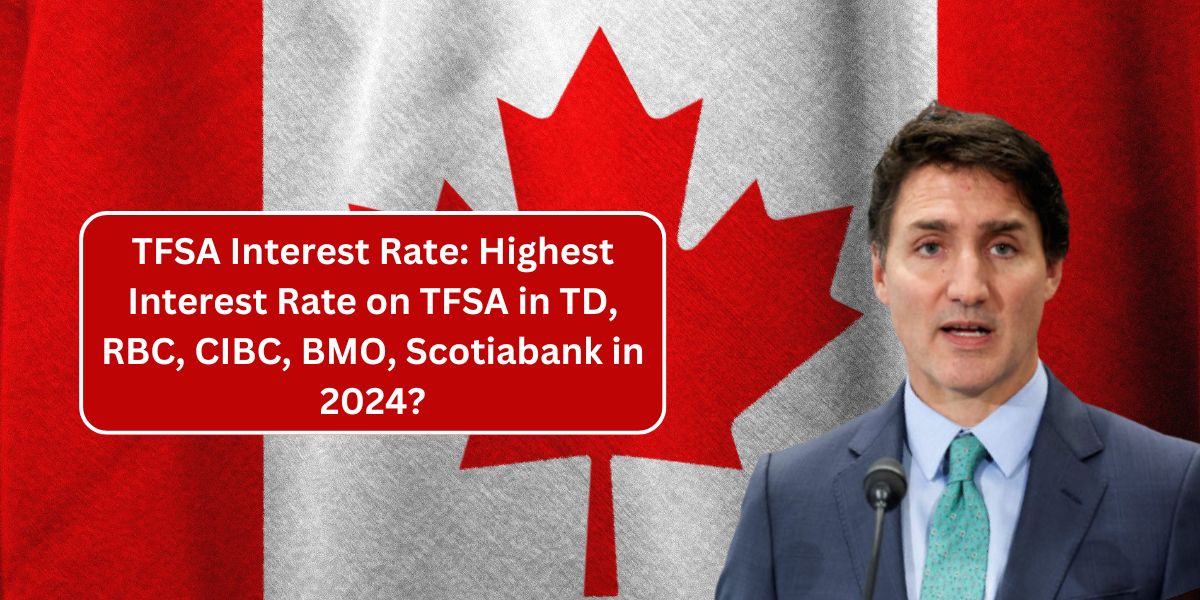If you’re looking to create a tax-free savings account and are unsure of which bank can offer good rates of interest, you are in the right place. Learn more in this article to know more about TFSA interest rates: Most High interest rate on TFSA at TD, RBC, CIBC, BMO, Scotiabank in 2024?
Table of Contents
TFSA Interest Rate
TFSAs is a savings account that are tax-free, and can be used for storing a range of investment options. The most effective tax-free high-interest savings account (TFSAs) provide high interest rates and low costs.
A registered plan that earns tax-free returns is a savings account that is tax-free (TFSA). With tax-sheltered benefits, high interest TFSAs work in a similar way to standard savings accounts.
This article we’re going to provide a thorough analysis of TFSA interest rate, how it is operation along with the rate of interest offered by high-end banks.
| 300 Reduction In Social Security Benefits |
| Thinx Lawsuit Class Action Payment 2024 |
| Johnson And Johnson Lawsuit 2024 |
| Canada 300 Federal Payment Announced |
| Ontario Teacher Pension Plan |
What is a TFSA?
Since 2009 Canadians received their first access to savings accounts tax free or TFSAs. Savings accounts aren’t the only thing these tax-free accounts TFSAs are used for. It makes sense since it lets you increase your savings even more than regular savings accounts or an account with high interest that isn’t TFSA-friendly.
While TFSAs are able to house a range of investments, they may also be utilized as a savings account to store cash. TFSAs are a great way for individuals to build the wealth of their medium- and long-term through taking advantage of tax-free compounding. They play a part in an individual’s portfolio.
The Federal Income Tax Act specifies guidelines for the functioning of TFSAs as well as it is the Canada Revenue Agency (CRA) is responsible for monitoring and enforcing these guidelines.
TFSA Interest Rate Overview
| Article Head | TFSA Interest Rate |
| Country | Canada |
| Availability | In various Banks |
| Interest | Varies from bank to |
| Minimum Balance | Usually, it is not stated. |
| Fees | Generally, there is no cost |
Highest Interest Rate in 2024
In comparison to other kinds of tax-free savings account or traditional savings accounts high-interest TFSA provides a greater interest rate.
The TFSA rates for the top Canadian common banks are available here. Use this information to determine the bank that will provide you with the best interest rates for 2024.
| Name of the Bank | TFSA Rate for 2024 |
| TD | 2.5% to 3.6% |
| RBC | 3.3% to 4.5% |
| CIBC | 0.9% to 4.5% |
| BMO | 1% to 2.5% |
| Scotiabank | 0.8% to 3.6% |
The rate of interest you earn is set by the institution which is where your TFSA is located. Online-only banks typically offer more interest rates than conventional credit unions and banks do.
How to Open a TFSA?
Here are some steps to open a TFSA:
Step 1: Confirm Eligibility
- Ensure you meet the eligibility requirements: You must be a resident of Canada and at least 18 years old, with an active Social Insurance Number (SIN). If you are not a Canadian resident but are 18 years old and have an active SIN, you are also eligible to apply for a TFSA.
Step 2: Select a TFSA Provider
- Choose an institution to open your TFSA. Options include banks, credit unions, insurance firms, trust companies, brokerage firms, and robo-advisors. Research and compare their offerings to find the best fit for your needs.
Step 3: Gather Necessary Documentation
- Prepare the required documentation, which includes your SIN and date of birth. This information will be needed to open your TFSA.
Step 4: Open Your TFSA Account
- Contact your chosen provider to initiate the process of opening a TFSA. The procedure is similar to opening a standard bank account. Ensure you complete all necessary forms and provide the required documentation.
Step 5: Understand Non-Resident Contribution Rules
- If you are not a Canadian resident, be aware that contributions to a TFSA will be subject to a 1% tax per month. This is important to consider when planning your contributions.
Step 6: Monitor and Manage Your TFSA
- Once your TFSA is open, regularly monitor your account and manage your investments according to your financial goals. Keep track of any changes in TFSA rules or rates offered by your provider.
How to Choose the Best TFSA for You?
Step 1: Define Your Financial Goals and Risk Tolerance
- Determine Your Goals: Decide if you’re using the TFSA for short-term savings or long-term investments.
- Assess Risk Tolerance: Identify your comfort level with market risk. For low risk, consider savings accounts or GICs; for higher risk, consider stocks or equity funds.
Step 2: Evaluate Account Features and Options
- Compare Interest Rates and Fees: Look for competitive interest rates on savings accounts or GICs, and check for any fees associated with the account.
- Review Investment Options: If investing, ensure the TFSA offers the types of investments you want, such as stocks, ETFs, or mutual funds.
- Check Contribution Limits and Withdrawal Rules: Confirm that the account aligns with the annual contribution limits and allows flexible withdrawals.
Step 3: Assess the Institution’s Reputation and Services
- Research Customer Service and Security: Choose a reputable institution with good customer service and strong security measures for your account.
- Consider Additional Features: Look for convenient features like online access, mobile banking, and automatic contributions.
Step 4: Compare Providers
- Compare Banks and Brokerages: Evaluate different financial institutions, including banks and online brokerages, to find the one that best meets your needs in terms of fees, services, and account features.
Conclusion
In 2024, Canadians looking to maximize their savings with a Tax-Free Savings Account (TFSA) should carefully consider their options to secure the highest interest rates. Among the major banks, RBC and CIBC lead the pack with competitive TFSA rates, offering up to 4.5%. TD and Scotiabank follow with rates up to 3.6%, while BMO and CIBC provide lower maximum rates of 2.5% and 4.5%, respectively.
When selecting a TFSA, it’s important to compare the interest rates offered by these banks and consider additional factors such as minimum balance requirements and any potential fees. Online banks often provide higher rates compared to traditional institutions, so exploring these options might also be beneficial.
By staying informed about the latest interest rates and account conditions, you can make the most of your TFSA, enhancing your savings and benefiting from tax-free growth.
FAQs
Which banks provide TFSAs with the most favorable conditions?
The Canadian banks that offer the highest interest rate per day and no minimum deposit requirements and no charges are the best choice for TFSA saving accounts. They include CIBC, Motusbank, Alterna Bank as well as EQ Bank.
What Can Be Placed in a TFSA (Tax-Free Savings Account)?
Bonds, stocks and mutual funds, exchange-traded funds (ETFs) and all GICs are just a few of the items you can place into the tax-free savings Account (TFSA) for you to make tax-free gains from your investments. It is important to remember that there are limits on contributions for your TFSA and any capital gains or income that you could earn through your investment.
What is the best way to get an TFSA that has the highest rates of interest?
Find the most attractive interest rates by looking at TFSA saving accounts on the internet. Find accounts that have an interest rate of, 2.50% or above. Also, make sure you be aware of any charges that could be connected to an account linked to a checking account.






